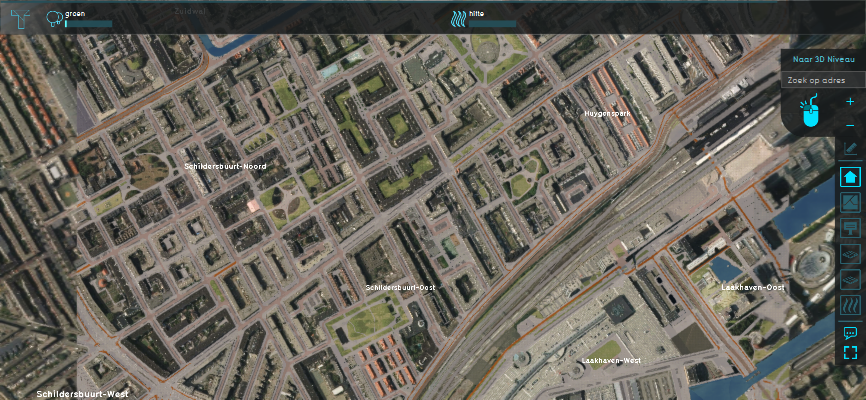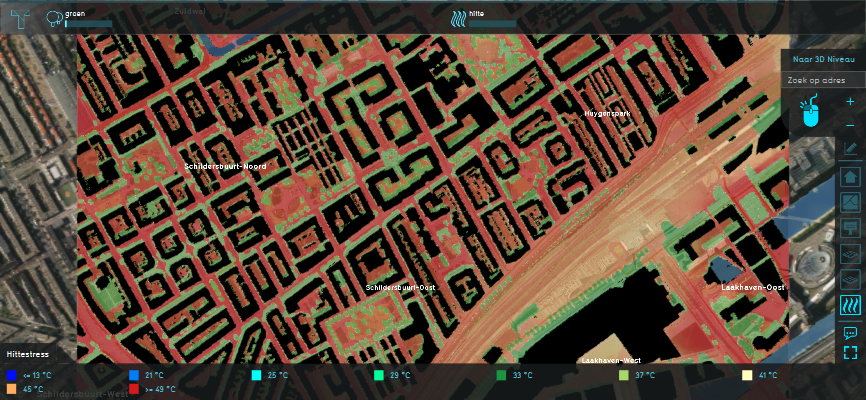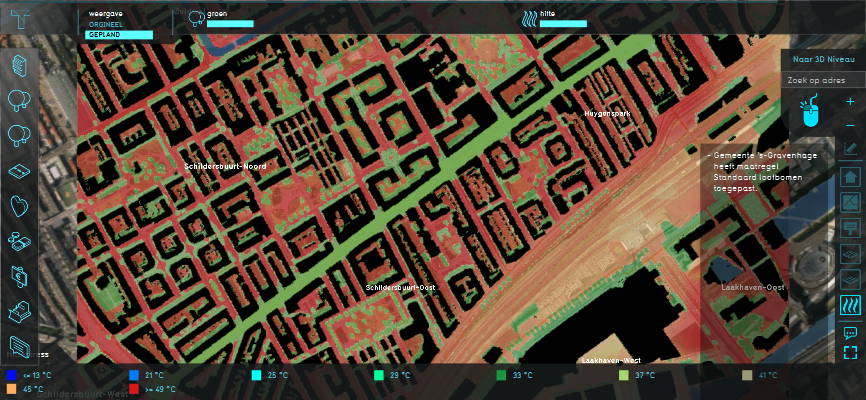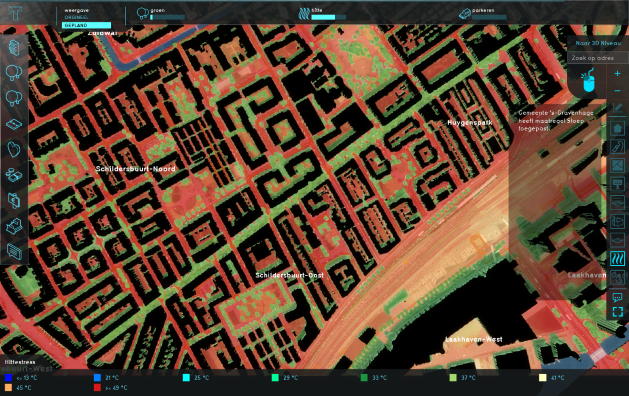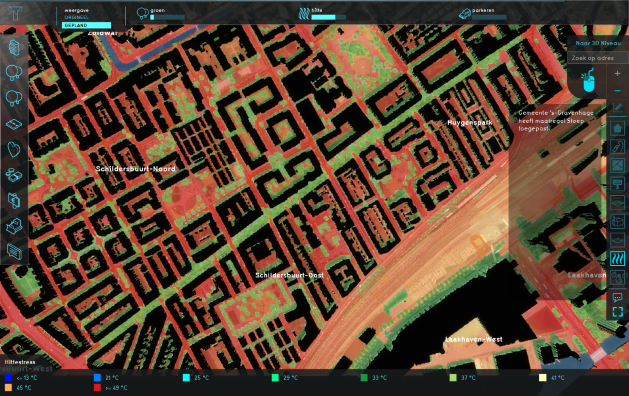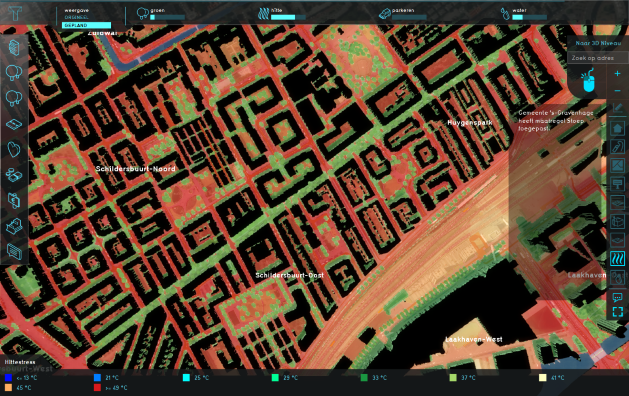Tygron for Spatial Planning: Difference between revisions
No edit summary |
No edit summary |
||
| Line 65: | Line 65: | ||
<gallery caption="Tygron model showing the absolute PET heat stress levels for different scenarios" mode="packed-overlay" heights=200px> | <gallery caption="Tygron model showing the absolute PET heat stress levels for different scenarios" mode="packed-overlay" heights=200px> | ||
File: | File:heatstreeshoefkade1.png|Scenario 1 (full of trees) | ||
File:heatstreeshoefkade2|Scenario 2 (municipality plan) | File:heatstreeshoefkade2.png|Scenario 2 (municipality plan) | ||
File:heatstreeshoefkade3.png|Scenario 3 | File:heatstreeshoefkade3.png|Scenario 3 | ||
File:heatstreeshoefkade4.png|Scenario 4 | File:heatstreeshoefkade4.png|Scenario 4 | ||
Revision as of 13:26, 4 March 2021
Use-case 3: “Proposals for a Greener Hoefkade”
A group of students of very different backgrounds used Tygron to develop an eco-consultancy plan for the municipality of the Hague, as an assignment for an area study course within their Sustainable Development interdisciplinary minor at the University of Leiden. In 4 weeks only, the team learned Tygron and created a complete plan for a greener Hoefkade neighborhood. Read more about this use-case.
Last year, students used Tygron for the first time in their course
Content of the course
General information
- Name of the course: "Area Study Sustainability Netherlands"
- Study Programme: Sustainable development (interdisciplinary minor)
- Educational Institute: Faculty of Science of Leiden University
Target students
To take part in the course Area Study Sustainability, students must have followed the previous courses Big Issues New Answers and Resilient Cities.
No prior knowledge of Tygron
Background of the working group:
- Annemiek de Looze International Studies
- Jos van der Sterre Molecular Science & Technology
- Veerle Cannemeijer International Relations & Organisations
- Max van Beek Molecular Science & Technology
Objectives and desired outcome
In this course you will explore a real-world and current sustainability challenge in a local city. In groups you will analyse the problem, its solutions and the factors that obstruct these solutions. This course gives ownership to the students in structuring the course and stimulates creative and critical thinking and dealing with complex issues. The area study will enable you to put into practice the theories and methods you have learned in class.
In groups, you provide sustainability advise to the City Councils of Leiden or The Hague. These cities have set ambitious goals and initiatives to become a much more sustainable city. When implementing these initiatives, the councils often realise that there are additional challenges. They therefore reach out to you, future sustainability experts, to provide recommendations on how to overcome some of the barriers or how they can have a larger impact.
Outcome: Students contribute to a blog, write a comprehensive advisory report and present their findings in a final presentation
Design of the Course
Syllabus and time distribution
4 weeks 7 credits
Guidance and Resources
This section is taken from the perspective of students who used Tygron for their report.
The main component of the course is the interdisciplinary group work, which is crucial to resolving sustainability challenges. There will also be lectures to provide additional content regarding the themes under study, field trips to provide context and opportunities for discussion.
In their project, the students investigated how the incorporation of greenery and climate adaptation measures could decrease the heat and flooding of Hoefkade.
How can more greenery and other climate adaptation measures be incorporated into the Hoefkade to mitigate heat stress and flooding while taking into account the opinions of residents and local employees?
In order to do that, the students developed five different scenarios: the current situation, the all green scenario, the current redevelopment plan and two greener alternatives. For all of these scenarios, the group has used the Tygron Geodesign Platform in order to test the effects that the incorporation of greenery would have on flooding and heat. In the performed tests of the scenarios, the students used
the heat stress overlay and the water overlay integrated into the Platform. In order to measure how the situation has changed in the played scenarios a number of indicators such a modified version of the heat stress indicator, water indicator and the parking space indicator were used.
Outcome and Assessment
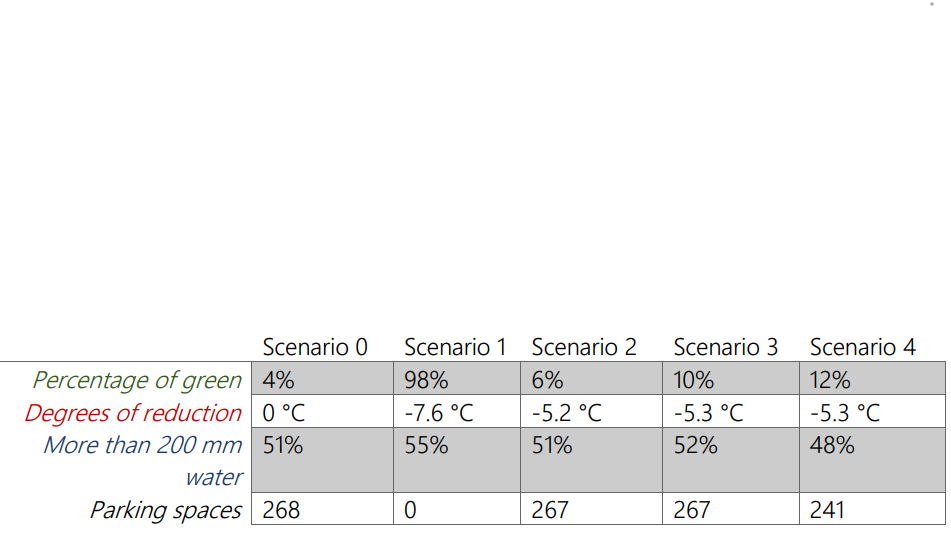
The tests performed in the Tygron software the students were able to conclude that the current plans for the Hoefkade will already prove to be effective and will reduce the heat up to 5,2oC. By simulating the green scenarios, they found out that adding even more greenery will only reduce the heat with an extra 0,10C. The tests with the Tygron Platform have shown that out of all green measures, trees are the most effective in reducing the temperature. While greenery proved to be the perfect solution in decreasing heat, it did not sufficiently reduce the problem of flooding. The tests in the Platform helped the students to find out that an effective solution for flooding could be water storage tanks and permeable bricks.
Feedback and recommendations
One of the biggest limitations for us was the different grid sizes
in Tygron. Some objects possess great precision, such as buildings loaded in from the plan of the municipality, while the heat and water overlays were limited to 0.5 m x 0.5 m. This made it difficult to accurately draw other objects into the programme, such as facade gardens or trees. The way Tygron calculates and uses different terrain types also caused some problems, forcing us to treat grass and fallow land as the same. Moreover, the biggest limitation with regards to calculating water stress was the automatically generated sewer system, as Tygron did not load in any sewer data. More research into the sewer of the Hoefkade is certainly recommended to find out if our water stress calculations are accurate. Moreover, the limited time we had to conduct this research led to us making certain assumptions in Tygron without having researched them thoroughly. Examples of this include tree size, locations of facade gardens, and the location of parking spots we chose to delete. This is something for the municipality to look into more precisely.
"It’s is really nice to see how Tygron makes a conceptual thing like a scenario a lot more concrete, making it come alive in front of the students." Dr. Benjamin Sprecher – Leiden University
"Tygron really brought our project to life. It was very interesting to be able to directly see the consequences of our ideas in the program. With Tygron we were able to make very concrete scenarios and that gave our project a lot of added value. We therefore hope that the municipality can do something with our findings to make the Hoefkade a bit more beautiful and sustainable." Annemiek de Looze & Veerle Cannemeijer – the authors of the project
Contact
For more information about this course, you can contact us at: info@Tygron.com
You can also reach Max van Beek, a member of the working-group that used Tygron for this course: mcvanbeek@live.nl
Course Lecturer: Benjamin Sprecher
| <<Previous page | Next page>> |
